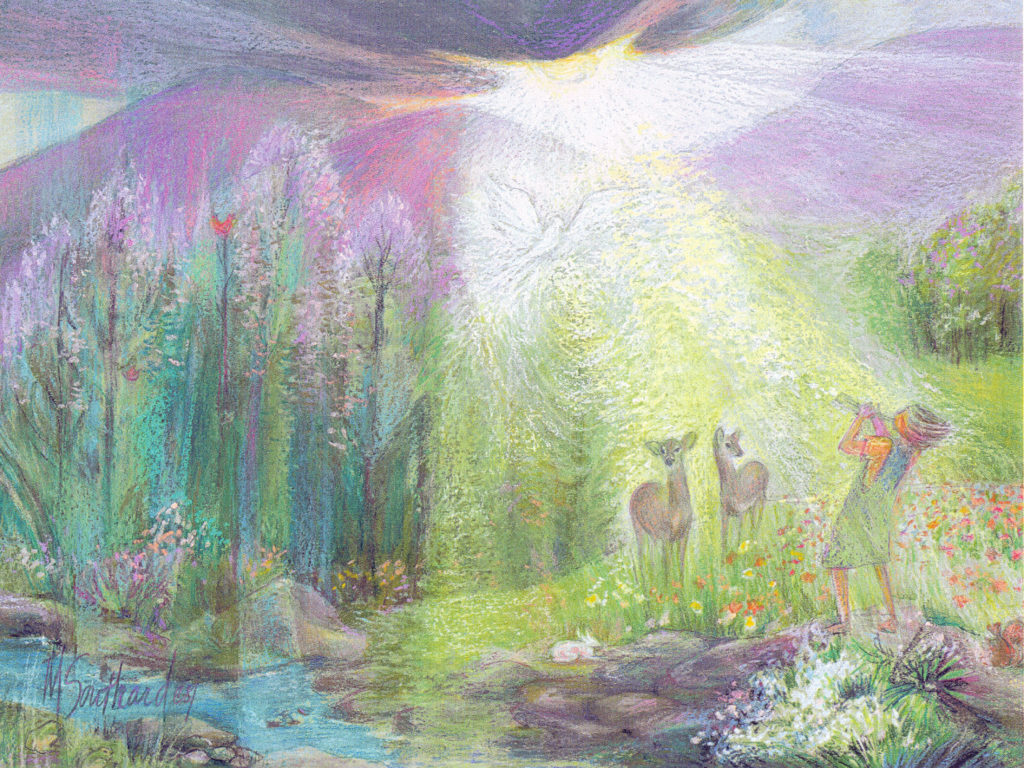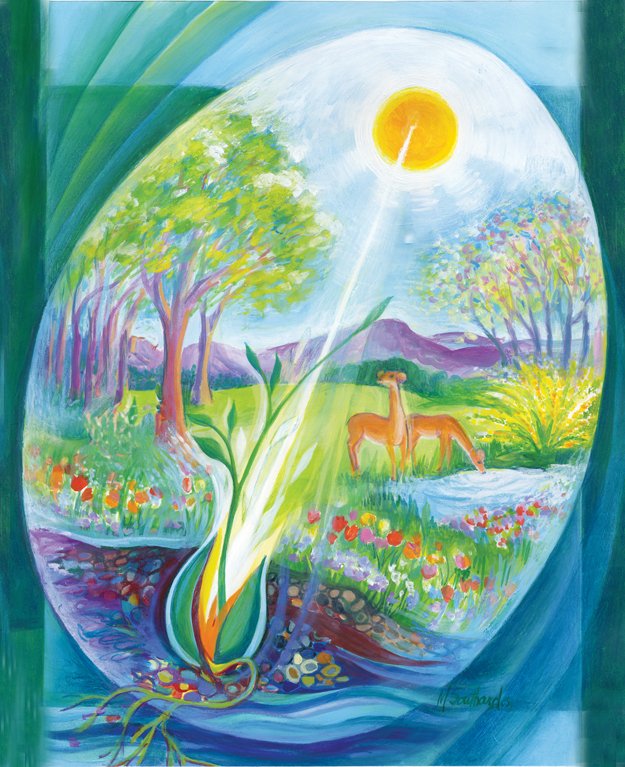April 1, 2018
The original idea of any sacred festival is to make the human being look upward from his dependence on earthly things to those things that transcend the Earth. – Rudolf Steiner
This Easter image from Mary Southard, CSJ, has always been a favorite of mine. It seems to embrace the many aspects of “Easter”, from Eostre (the pagan festival of rebirth and new life) to Easter (the holiest festival for Christians celebrating the resurrection of Christ.) I have always loved the fact that the Christian festival of Easter is celebrated on the first Sunday after the first full moon on or after the Vernal Equinox. Unlike other holidays that are celebrated conveniently on a particular calendar day, Easter is tied to the movement of the starry heavens. In many ways, modern religion has completely lost touch with the fact that the physical world of nature has anything at all to do with the spiritual world. The festival of Easter is a powerful reminder to us that Creation is sacred. In springtime, with the opening of the buds and the greening of the world around us, we are reminded that the earth itself celebrates Resurrection, and we humans are part of the glorious mystery, not separate from it. May we each experience rebirth this day, whatever our spiritual path.

(Mary O’Connell, Your Living Arts Weekly Blog Editor)
Sing a song of seasons, as round and round they go
No matter where on Earth you live, the changes always show!
A teeny, tiny poem by Pamela Perkins
Practical Activity
Spring Festival Bread Bunnies
from Sharifa Oppenheimer
Sharifa Oppenheimer is the author of Heaven on Earth: A Handbook for Parents of Young Children and What is a Waldorf Kindergarten. She taught young children for 35 years and now loves teaching adults through the LifeWays trainings. She also travels offering lectures which explore the ways in which the latest findings in brain research support Steiner principles. Sharifa lives with her husband in an enchanted forest in Virginia, and is the mother of three grown sons, who were raised within the Waldorf tradition.
Sharifa says, “For our Spring Festival, we make festive Bread Bunnies with our weekly bread recipe below ~ with extra honey and cinnamon ~ and then shape the dough into bunnies!”
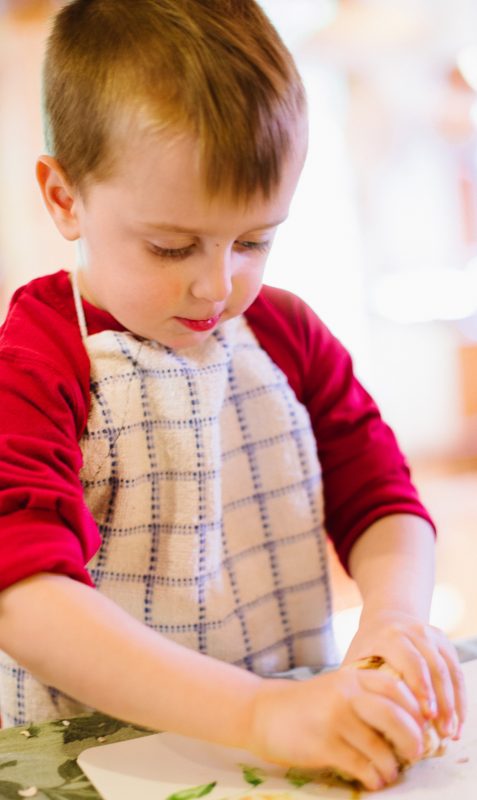
Honey Bread
Preheat oven to 350 degrees, oil a baking sheet
This recipe makes about 24 bunnies; make a half recipe for 12
In a separate bowl, melt
—half stick butter into
—1.5 cups boiling water
—set aside to cool
In the bread bowl, dissolve
—2 Tablespoons dry bakers yeast in
—1 cup lukewarm water
—add a spoon of honey and stir
—set this aside to let yeast bubble.
When butter water is lukewarm, add to the bubbly yeast mixture.
—Add half cup honey ( more to taste )
—Add 1 Tablespoon cinnamon
—Add 1 teaspoon salt
—Now, one cup at a time, add 7-8 cups whole wheat flour.
—When it is too thick to stir, turn out onto a floured board and knead.
—Add or delete flour as needed for a springy, responsive dough.
No need to let rise and punch down!
—Now with the children’s help, form into bunny shapes
—a piece of dough the size of a tennis ball makes a medium sized bunny
—See photo below for bunny-shape. Children’s bunnies are on top. Look at bunnies on the bottom to see bunnies shaped by the teacher 😉
—Place on oiled baking sheet
—Bake at 350 for about 25-30 minutes. Check for doneness. Add more time if needed.
—Butter the bunnies while hot
Serve with honey butter or apple butter.
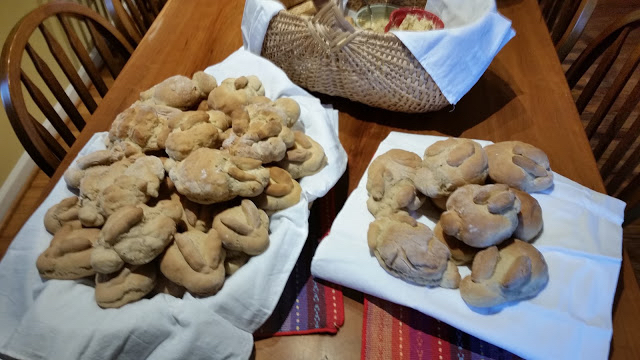
Nurturing Care
Fair Spring – Spring Fare
by Pamela Perkins
(Author’s note: The following is a revised version of an article that I wrote under the auspices of a grant from the Anthroposophical Society of America’s Future Value Fund back in 1996. Many of you who read this LifeWays Weekly blog were likely those children I was concerned for when I wrote it. The situation which seemed critical back then, is now, as you know all too well, exponentially more complex and dire. Yet the basic principles of sound nutrition as indicated by Rudolf Steiner, and the basic developmental needs of the young child have NOT changed.)
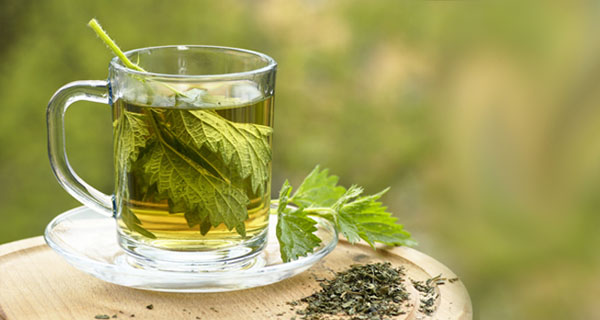
We are all aware that children’s nutrition is of vital importance. Incidents of diseases which formerly manifested primarily in adults now plague younger and younger children. Pollution in cities affects the lungs causing lesions which are evidence of what Dr. Russell Sherwin of the University of Southern California calls “destructive, irreversible disease in young people.” (1) Childhood allergies increase, behavioral difficulties increase, virulent influenza outbreaks and other indications of deficient immune systems can cause fear and anxiety among parents and caregivers.
Where do we begin as adults to find firm footing in the storm? How can we provide healing and nurturing in the course of our often overly busy daily lives? What practical means can we employ to implement the knowledge and understanding we acquire about child development, healthy nutrition, and nurturing environments? How can we ‘digest’ the information we read or hear, and how do we strengthen our ‘metabolic forces’ so that can we intuitively reflect this knowledge in the practical creation of our daily meals?
As a born-and-bred New Englander, I have always had a fondness and appreciation for stone walls – not the jumbled heaps of rock hurled out of a potential pasture, but those careful, neat encompassing borders of perfectly fitted, flat-topped stone. I once stood admiring the beautiful stone wall an elderly neighbor was carefully mending and asked him how he had done it. He methodically finished levering a huge stone in place, gradually straightened up, then looked me straight in the eye. After a moment’s careful consideration, he replied laconically, “One stone today, another tomorrow”, and proceeded to go back to his work without another word.
I wish in this day of ‘instant everything’ I could offer a simple, definitive solution to the problems mentioned above. But there is nothing that I can share which would truly suffice as a straightforward, cut-and-paste recipe one can read per se and outwardly adopt. The way to build our understanding is ‘stone by stone’. If one is given a barren, weather-worn plot of earth and the task to create a fruitful garden, much patience is required to balance environmental influences, and to nourish and replenish the soil. In our caregiving, families may come to us who may have little experience with whole foods, or an understanding of how to incorporate children into the food preparation process. This is not meant to be judgmental: it is simply an observation born of experience. Modern life is too often a fast lane of overscheduling and consequent ‘eat-to-fill-bellies-expediently” meals, in spite of all good intentions. Diligent, consistent effort is necessary to maintain a garden once it has been established, so that each new planting of seeds will continue to germinate, root strongly and thrive, thus providing us with ongoing abundant harvests. As with Biodynamic gardening, healthful nutrition that provides true nourishment for the developing child, while at the same time meets each child’s individual needs, requires careful observation of the individualities involved, a deepening understanding of the growth processes, and disciplined, patient effort. Experience, a bit of trial and error, plus reflective thinking lead to the gradual development of an intuitive sense for the dynamic processes involved in nourishing children, as well as in nurturing a garden or farm.
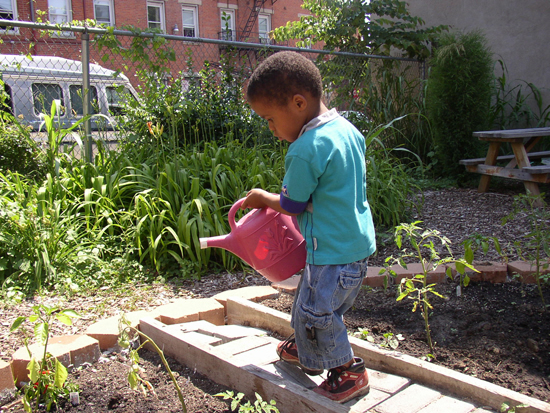
As we involve children in the process of growing, harvesting, and preparing regular daily meals and snacks, we are helping them to establish healthy, life-long, rhythmical habits. Out of our efforts and commitment to caring for children in the daily course of practical routine activities, through our striving to deepen our understanding, we are modeling for them our highest ideals, to which we give ourselves with love and devotion. Children need to experience these qualities from us. Mechanistic, materialistic and hedonistic forces plague our times. We need to do all that we can to counter these tendencies, not only for the children’s wellbeing now, but for our children’s future as well. (2) Amidst the maelstrom of subconscious and unconscious forces surrounding us like a thick fog, we adults are also struggling to strengthen our will, and to expand our perceptive and intuitive capacities. In a seemingly humble but nonetheless powerful way, we can begin to positively affect our health, our children’s health, and our environment’s heath, fork by mouthful every day.
As Stephen Chalmers, chef at High Mowing School, so aptly pointed out at the first Annual Anthroposophical Cooks’ Conference in Harlemville, N.Y. (3), the daily task of food preparation can be taken up as path of inner spiritual development. It affords us many opportunities from garden to kitchen to table, through our learning to carefully observe growing plants, our becoming sensitive to the nuances of seasonal changes, as well as through our engaging the children and ourselves in ongoing artistic creativity.
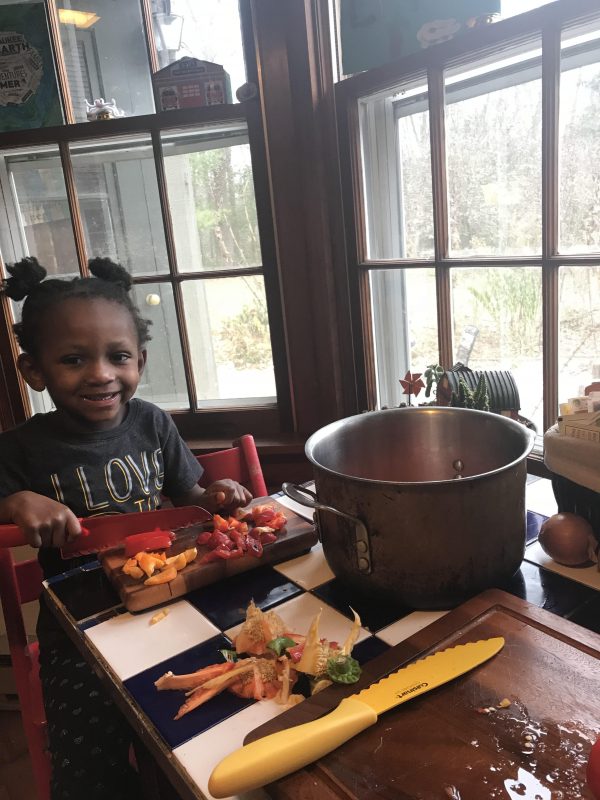
Footnotes from the 1996 version, noted above.
(1) International Wildlife. Vol. 25, Number 5, Sept-Oct 1995, p.42.
(2) Hearth Song. Montgomery Village, Santa Rosa, CA
(3) Anthroposophical Nutrition Working Group, PO Box 1001, Great Barrington, MA 01230.
Journal Prompt
from Kerry Ingram, a mom, foster mom, LifeWays grad, board member and Waldorf trained teacher. She is the founder of Mothering Arts which supports women with all the tools and inspiration they need to create a local postpartum nurturing group. You can find her enjoying the magic of nature with her family and community in northern California.
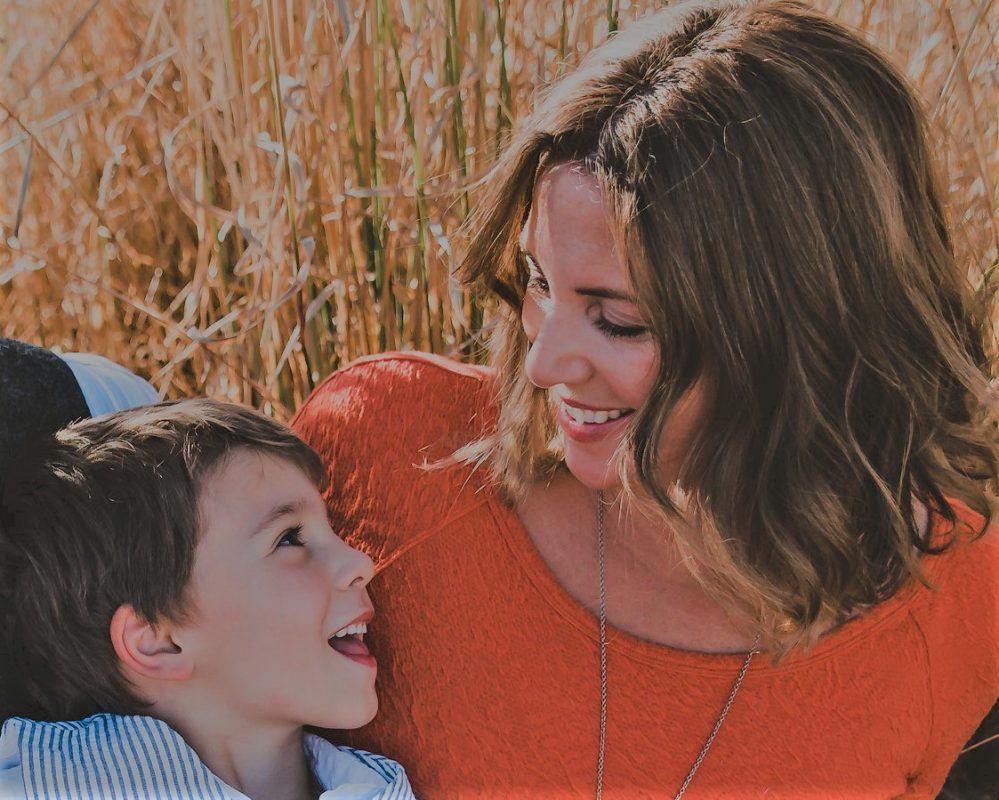
Creative Exploration
Daphne the Curious Little Donkey
And the Spring Snow Storm
(continued from last week’s Living Arts Weekly…)
This story comes to us from Pamela Perkins, who has worked with and for children in various capacities since 1970. A former Waldorf teacher, LifeWays graduate and home provider, she now delights in being with her five granddaughters, plus creating magical needle-felted puppet stories and writing gentle tales to nurture young and old. She lives in the Upper Valley of Vermont, and is working on her new writing project Silver Seedlings – Nurturing Tales for the Young and Young at Heart.
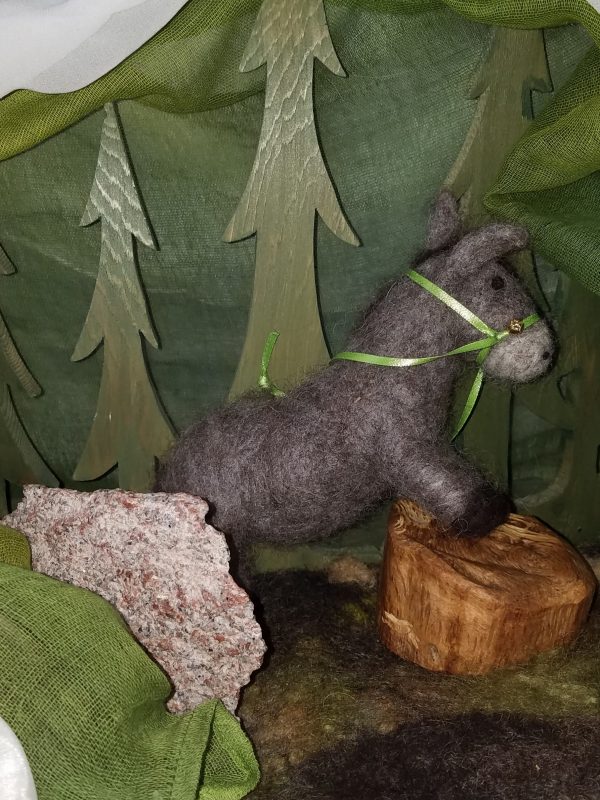
Chapter Five: Old Mother Squirrel
Meanwhile, deep in the woods, the naughty little donkey was huddled miserably, but safely, beneath the low-hanging boughs of a large spruce tree. When the storm first hit, Daphne had panicked and ran around frantically in an attempt to find her way out of the forest. Pausing to catch her breath, she leaned against the trunk of an oak tree and began to cry. She let out a long, high-pitched little donkey wail.
Kindly Old Mother Squirrel was in the tree overhead. She heard her from inside her twiggy dray and came scooting down the trunk. “Quick! Quick! Follow me and be ever so quick, quick, quick!”, she chattered. Daphne looked up through her tears and followed her. She led her confidently through the swirling snow to a nearby giant spruce tree and dove underneath its protective boughs. Daphne pushed her way through after her.
The ground was covered with sweet smelling needles and soft moss; the wind and snow could not reach inside of the shelter. Daphne was safe. It was warmer here beneath the boughs, and she was not alone, for kindly Old Mother Squirrel had promised to stay with her until the storm was over. She had a stash of nuts and seeds hidden in a chink in the tree, which they both nibbled. To pass the time, she told her stories, and soon, that curious little donkey folded her legs, lay down and went to sleep.
Back at the farm, Maeve and her parents were back in the house once more. They had left the animals well-fed, watered and secure in the barn. Maeve’s mother had gone back out and secured a rope ‘handrail’ all along the walkway posts between the barn and the house, to make it safer to navigate back and forth later on. A good supply of firewood was stacked by the woodstove, the firebox heaped to overflowing, the extra water containers were filled, and candles, matches and lanterns had been set out. A pot of savory stew bubbled on the gas stove and biscuits baked in the oven. Everything smelled delicious and they were all cozy and warm. In each one’s mind was the hope that Daphne had found shelter and had not gotten hurt. Nothing else could be done.
The storm turned out to be a classic three-day Nor’easter. The farm chores had to be done twice each day and took longer than usual. The woodstove had to be stoked continually. But everyone was safe inside the snug house and barn. In between chores, the family passed the time eating and playing music, reading and playing games together. Of course, they all wondered and worried about Daphne.
Back in the forest, Daphne nibbled a few blades of old grass underneath the tree and ate a few more of kindly Old Mother Squirrels’ store of seeds and nuts. She poked her nose through the branches and licked up snow to quench her thirst. Her tummy rumbled. She only complained once to Old Mother Squirrel, who looked at Daphne with her kind, wise eyes and asked one question: “Tell me again, how did it happen that you ended up lost in the woods and are not home in your safe snug barn?” Daphne opened her mouth, then thought a minute, and shut it again.
Daphne was beginning to change. She was beginning to think about her actions and to learn from her mistakes. She decided that she would make better choices another time. She knew that she might have been hurt or eaten by hungry coyotes or … she shivered. She knew that she was a very, very lucky little donkey.
Chapter Six: Daphne Finds Her Way Home
Finally, the storm let up. The clouds thinned, shredded and blew away as a warmer south wind moved in. The sun can out and everyone, from man to beast, let out a sigh of relief. Late spring storms come quickly, but the snow they leave behind also melts quickly.
Daphne, guided by kindly Old Mother Squirrel, pushed her way through the forested tangle of branches and trunks, and out into the open fields close to her home. The snow was still deep in places, but she could see the farm in the distance. She brayed in happiness and thanked her friend. She promised Old Mother Squirrel that she would be more thoughtful in the future. She was anxious to get back home, because she now realized that Maeve, whom she loved dearly, must be terribly worried.
Slowly she ploughed through the wet snow. It was beginning to melt in the bright Spring sunlight and was heavy. Suddenly, she spotted people wading slowly through the snow, heading her way across the fields. Was it? Yes! It was Maeve and her mother and father!
Daphne let out a loud, happy little donkey shout, and kicking up her heels, jumped and leapt through the snow to reach them. They first heard, and then saw her, and they too, shouted and ran as fast as they could to meet her. Maeve hugged and hugged her. All was well. Back at the barn, her mother checked Daphne over carefully. She was not hurt, but she did have a cold, and had to stay inside the barn for two weeks, even on the nicer days that followed.
At last, the snow completely melted, even along the hedgerows and under the trees in the forest. The fence was checked thoroughly and mended. School had resumed, and life around the forest and farm settled into the gentler, if busy, rhythm of Springtime. And Daphne? Well, that is another story for another day, and the next chapter.
(Join us next week for the last installment of Daphne, the curious little donkey!)
Social Awareness
Here is a list of significant dates occurring in the next few months. Perhaps you might choose to create a simple festival to celebrate one of these days in your home or program. May your Spring festival celebrations help you connect to that which is sacred in your life!
(The image is another of Mary Southard’s, called “Ode to Spring”.)
